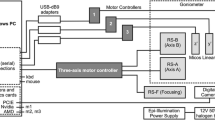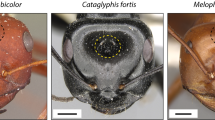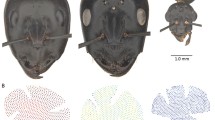Summary
-
1.
The directions of the axes of all ommatidia in the frontal eye regions of 2 species of fly (Calliphora erythrocephala andLucilia cuprina, both sexes) were mapped onto the surface of a sphere. This was done by photographing the pseudopupil in white-eyed mutants.
-
2.
In both sexes of both species there is a region with a high density of ommatidial axes (an acute zone), situated frontally and slightly above the equator. In females the centre of this region is only about 5° above the equator (Lucilia andCalliphora); its location is similar in maleLucilia, but is 15° higher in maleCalliphora. The maximum density of ommatidial axes is about 1 per deg2 inLucilia (both sexes) andCalliphora males; it is lower inCalliphora females (0.7 per deg2). These densities are roughly 3 times higher than at 60° from the front.
-
3.
We have used the data given by Beersma et al. (1975), to produce a similar map for a maleMusca domestica. The results differ from the other species mainly in that the overall density is lower, the maximum being 0.4 axes per deg2, 20–25° above the equator.
-
4.
Using these data and others from the literature we arrive at the following conclusions: (i) the regions of highest resolution and highest ommatidial diameter coincide closely, (ii) the region of greatest binocular overlap lies well above the centre of the acute zone, 20° higher in maleCalliphora. (iii) the ‘7r domain’ in maleMusca (Hardie et al. 1981) corresponds closely with the acute zone, (iv) the fields of view of the male-specific lobula interneurones MLG3 and Col D (Hausen and Strausfeld 1980) include the acute zone centre but also most of the dorsal part of the field of view. This is consistent with a function related to chasing.
-
5.
Differences in function of male and female acute zones are discussed. It seems likely that there are two kinds of acute zone in insect eyes, one concerned with forward flight and the other with the detection and capture of other insects. We also argue that ‘fovea’ should not be used to mean a region of high ommatidial axis density.
Similar content being viewed by others
References
Beersma DGM, Stavenga DG, Kuiper JW (1975) Organization of the visual axes in the compound eye of the flyMusca domestica L. and behavioural consequences. J Comp Physiol 102:305–320
Beersma DGM, Stavenga DG, Kuiper JW (1977) Retinal lattice, visual field and binocularities in flies. Dependence on species and sex. J Comp Physiol 119:207–220
Braitenberg V (1967) Patterns of projection in the visual system of the fly. I. Retina-lamina projections. Exp Brain Res 3:271–298
Braitenberg V (1972) Periodic structures and structural gradients in the visual ganglia of the fly. In: Wehner R (ed) Information processing in the visual systems of arthropods. Springer, Berlin Heidelberg New York, pp 3–15
Burkhardt D, de la Motte I (1983) How stalk-eyed flies eye stalk-eyed flies: observations and measurements of the eyes ofCyrtodiopsis whitei (Diopsidae, Diptera). J Comp Physiol 151:407–421
Collett TS (1980) Some operating rules for the optomotor system of a hoverfly during voluntary flight. J Comp Physiol 138:271–282
Collett TS, Land MF (1975) Visual control of flight behaviour in the hoverflySyritta pipiens L. J Comp Physiol 99:1–66
Dietrich W (1909) Die Facettenaugen der Dipteren. Z Wiss Zool 92:465–539
Franceschini N (1975) Sampling of the visual environment by the compound eye of the fly: fundamentals and applications. In: Snyder AW, Menzel R (eds) Photoreceptor optics. Springer, Berlin Heidelberg New York, pp 98–125
Franceschini N, Kirschfeld K (1971) Les phénomènes des pseudopupille dans l'oeil compose deDrosophila. Kybernetik 9:159–182
Franceschini N, Münster A, Heurkens G (1979) Äquatoriales and binokulares Sehen bei der FliegeCalliphora erythrocephala. Verh Dtsch Zool Ges 72:209
Gibson JJ (1950) The perception of the visual world. Riverside Press, Cambridge Mass
Hardie RC (1983) Projection and connectivity of sex-specific photoreceptors in the compound eye of the male housefly (Musca domestica). Cell Tissue Res 233:1–21
Hardie RC, Franceschini N, Ribi W, Kirschfeld K (1981) Distribution and properties of sex-specific photoreceptors in the flyMusca domestica. J Comp Physiol 145:139–152
Hausen K (1981) Monocular and binocular computation of motion in the lobular plate of the fly. Verh Dtsch Zool Ges 74:49–70
Hausen K (1984) The lobula-complex of the fly: structure, function and significance in visual behaviour. In Ali MA (ed) Photoreception and vision in invertebrates. (NATO ASI Series A, vol 74). Plenum, New York, pp 523–559
Hausen K, Strausfeld N (1980) Sexually dimorphic interneuron arrangements in the fly visual system. Proc R Soc Lond B 208:51–71
Hengstenberg R (1984) Roll stabilization during flight of the blowfly's head and body by mechanical and visual cues. In: Varjú D, Schnitzler H-U (eds) Localization and orientation in biology and engineering. Springer, Berlin Heidelberg New York Tokyo, pp 121–134
Hooke R (1665) Micrographia, or some physiological descriptions of minute bodies made by magnifying glasses. J Martyn J Allestry, London
Horridge GA (1978) The separation of visual axes in apposition compound eyes. Phil Trans R Soc Lond B 285:1–59
Hughes A (1977) The topography of vision in mammals of contrasting life style: comparative optics and retinal organization. In: Crescitelli F (ed) The visual system of vertebrates. Springer, Berlin Heidelberg New York, (Handbook of sensory physiology, vol VII/5, pp 613–756)
Kirschfeld K, Wenk P (1976) The dorsal compound eye of simuliid flies: an eye specialized for the detection of small, rapidly moving objects. Z Naturforsch 31c:764–765
Kuiper JW (1966) On the image formation in a single ommatidium of the compound eye of Diptera. In: Bernhard CG (ed) The functional organization of the compound eye. Pergamon Press, Oxford, pp 35–50
Land MF, Collett TS (1974) Chasing behaviour of houseflies (Fannia canicularis). J Comp Physiol 89:331–357
Laughlin SB (1981) Neural principles in the visual system. In: Autrum H (ed) Vision in invertebrates. Springer, Berlin Heidelberg New York. (Handbook of sensory physiology, vol VII/6B pp 133–280)
Maldonado H, Barros-Pita JC (1970) A fovea in the praying mantis eye. I. Estimation of the catching distance. Z Vergl Physiol 67:58–78
Praagh JP van, Ribi W, Wehrhahn C, Wittmann D (1980) Drone bees fixate the queen with the dorsal frontal part of their compound eyes. J Comp Physiol 136:263–266
Ribi W (1978) Ultrastructure and migration of screening pigments in the retina ofPieris rapae L. (Lepidoptera, Pieridae). Cell Tissue Res 191:57–73
Rossel S (1979) Regional differences in photoreceptor performance in the eye of the praying mantis. J Comp Physiol 131:95–112
Sherk TE (1978) Development of the compound eyes of dragonflies. III. Adult compound eyes. J Exp Zool 203:61–80
Snyder AW (1977) Acuity of compound eyes: physical limitations and design. J Comp Physiol 116:161–182
Snyder AW (1979) Physics of vision in compound eyes. In: Autram H (ed) Vision in invertebrates. Springer, Berlin Heidelberg New York (Handbook of sensory physiology, vol VII/6A pp 225–313)
Stavenga DG (1979) Pseudopupils of compound eyes. In: Autrum H (ed) Vision in invertebrates. Springer, Berlin Heidelberg New York (Handbook of sensory physiology, vol VII/ 6A). pp 357–439
Wagner H (1982a) Flow-field variables trigger landing in flies. Nature 297:147–148
Wagner H (1982b) Flight manoeuvres of freely flying flies (M. domestica L.): aspects of kinematics and visually guided behaviour of females. Verh Dtsch Zool Ges 75:338
Wagner H (1985) Flight performance and visual control of flight of the freely flying housefly (Musca domestica L.). Thesis, University of Tübingen
Walls GL (1942) The vertebrate eye and its adaptive radiation. Hafner, New York
Wehner R (1981) Spatial vision in arthropods. In: Autrum H (ed) Vision in invertebrates. Springer, Berlin Heidelberg New York (Handbook of sensory physiology, vol VII/6C pp 287–616)
Wehrhahn C (1979) Sex-specific differences in the chasing behaviour of houseflies (Musca). Biol Cybern 32:239–241
Wehrhahn C (1984) Visual orientation of flies in flight. In: Varjú D, Schnitzler H-U (eds) Localization and orientation in biology and engineering. Springer, Berlin Heidelberg New York Tokyo, pp 112–118
Wehrhahn C, Reichardt W (1975) Visually induced height orientation of the flyMusca domestica. Biol Cybern 20:37–50
Wehrhahn C, Poggio T, Bülthoff H (1982) Tracking and chasing in houseflies. An analysis of 3-D flight trajectories. Biol Cybern 45:123–130
Zeil J (1983a) Sexual dimorphism in the visual system of flies: the compound eyes and neural superposition in Bibionidae (Diptera). J Comp Physiol 150:379–393
Zeil J (1983b) Sexual dimorphism in the visual system of flies: the free flight behaviour of male Bibionidae (Diptera). J Comp Physiol 150:395–412
Author information
Authors and Affiliations
Rights and permissions
About this article
Cite this article
Land, M.F., Eckert, H. Maps of the acute zones of fly eyes. J. Comp. Physiol. 156, 525–538 (1985). https://doi.org/10.1007/BF00613976
Accepted:
Issue Date:
DOI: https://doi.org/10.1007/BF00613976




